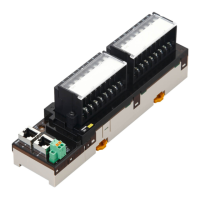
Do you have a question about the Omron GX-ID1611 and is the answer not in the manual?
| Brand | Omron |
|---|---|
| Model | GX-ID1611 |
| Category | Touch terminals |
| Language | English |
Explains the layout and components of the manual's pages for better navigation.
Details the meaning and usage of various icons employed within the manual for safety and reference.
Identifies the target audience for this manual, requiring electrical knowledge and FA system experience.
Details the terms of warranty, limitations on liability, and buyer's remedies for product defects.
Outlines precautions related to using the correct power supply voltage and ensuring stable power.
Details precautions for safely installing the units, including static discharge and proper mounting.
Provides precautions for wiring connections, including correct tool usage, polarity, and cable management.
Outlines the warning labels used to convey potential hazards and safety instructions.
Outlines compliance with relevant European Union directives, including EMC and Low Voltage directives.
Details compliance with UL and CSA standards and application conditions for machinery or systems.
Mentions compliance with KC standards and provides a precaution for using products in Korea.
Introduces EtherCAT as a high-performance industrial network system based on Ethernet.
Explains the various devices and components that constitute an EtherCAT network configuration.
Provides a general overview of EtherCAT Slave Units, including their types and features.
Lists and describes the different types of EtherCAT Slave Units available, including their appearance and I/O points.
Explains basic setup procedures using practical examples for configuring EtherCAT Master and Slave Units.
Details the process of setting up and wiring the EtherCAT Master Unit, Slave Units, and power supplies.
Describes the DIN track mounting method for various Slave Units, including preparation and removal.
Explains how to lay down the EtherCAT network, including precautions for cable connection.
Details the procedures and considerations for supplying unit power and I/O power to the slave units.
Provides instructions on how to connect external devices to the slave units via terminal blocks or connectors.
Explains the structure of the CAN application protocol over EtherCAT (CoE) used in GX-series EtherCAT Slave Units.
Describes the ESI file, which contains setting information for EtherCAT Slave Units, used for network configuration.
Illustrates the EtherCAT State Machine (ESM) and the transitions between states from power ON.
Explains Process Data Objects (PDOs) used for real-time data transfer via cyclic communications.
Describes the communication modes between the Master Unit and Slave Units, including FREE RUN and DC modes.
Provides EtherCAT communication specifications for GX-series Digital I/O, Analog I/O, and Encoder Input Slave Units.
Lists general specifications applicable to GX-series Digital I/O, Analog I/O, and Encoder Input Slave Units.
Details specifications for commonly mounted indicators, switches, and connectors across slave units.
Introduces Digital I/O Slave Units and their functions like input filtering and error mode output.
Explains how I/O data is allocated to input/output areas of the EtherCAT Master Unit's I/O memory.
Lists detailed specifications, names, internal circuits, and wiring diagrams for each Digital I/O Slave Unit model.
Provides the physical dimensions and mounting information for various Digital I/O Slave Unit types.
Introduces Analog I/O Slave Units and their functions for processing analog data like voltage and current.
Details the analog-to-digital conversion process, input ranges, and converted data formats for analog input.
Explains how digital data is converted to analog signals for output, covering output ranges and converted data.
Lists specifications, names, internal circuits, and wiring diagrams for each Analog I/O Slave Unit model.
Introduces Encoder Input Slave Units and their functions for processing encoder signals.
Explains how encoder data, including counter values and latch values, is allocated to I/O memory.
Lists specifications, names, internal circuits, and wiring diagrams for open collector and line driver input types.
Introduces IO-Link Master Units, their connection configuration, and supported software.
Explains how input and output data, including Sysmac error status, is allocated for IO-Link devices.
Provides detailed specifications for communications, unit requirements, and connector types for the IO-Link Master Unit.
Introduces Expansion Units, their connection methods, and I/O power supply requirements.
Lists specifications, names, internal circuits, and wiring diagrams for various expansion unit models.
Guides users on identifying and resolving errors based on status indicators and error codes.
Describes routine maintenance procedures, including cleaning, inspections, and handling requirements.
Defines the structure and format of objects within the CAN application protocol over EtherCAT (CoE) protocol.
Explains how to calculate the I/O power supply current required for slave units, considering different configurations.
Lists and defines key EtherCAT terms and abbreviations used throughout the manual for clarity.
Shows the correspondence between unit versions of slave units and compatible support software versions.